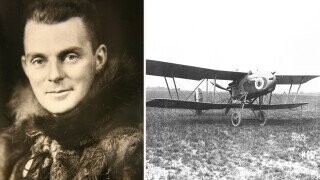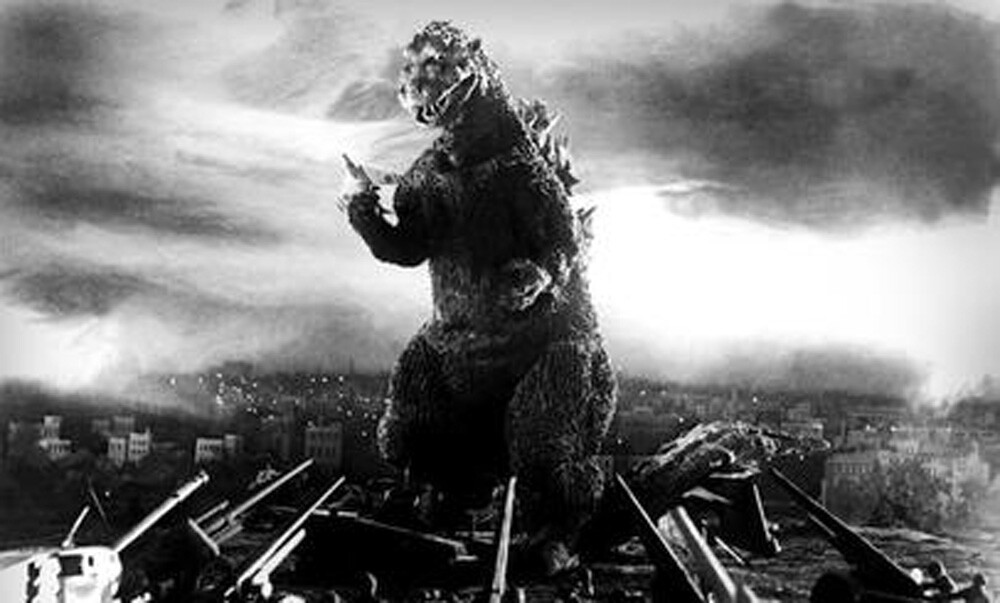Five Facts About Punch Dickins, The Ace Pilot Who Cheated Death Nonstop

Canada is a land of heroes. Who could forget John A. MacDonald, who became Canada’s first prime minister despite regularly getting so zonked on discount moonshine that he blacked out in Parliament, and even slept through an entire invasion of Canada. Then there was Alexander Keith, who made a beer so delicious that nobody even minded when his nephew killed 80 people. And the whole nation regularly cheers that legendary duo of Isaac Brock and Tecumseh, who conquered Detroit, then gave it right back to America again after realizing it was Detroit.
But we’re not here to talk about such storied figures. They all have museums and folk songs and public intoxication laws named after them. Instead, we’d like to talk about a man who is increasingly forgotten. A man who has been featured on Canadian stamps, yet is tragically unknown outside his native land. A man who undoubtedly changed the world, although perhaps not entirely for the better. We’re talking, of course, about Punch Dickins.

via Wiki Commons
Don't Miss
Now, obviously this article will be a challenge for us. We’re used to writing about humorous topics, but there’s nothing funny about Punch Dickins, the man who toured the world showing off his versatile Beaver. We’re talking about a guy who once broke his mighty Fokker slamming into the Great Bear. What jokes could we possibly make? We just think that Punch Dickins was an interesting guy and it’s a shame that his name now sounds like he’s the only X-Man with a worse power than Dazzler.
Punch Dickins Vs The Flying Circus
Clennell “Punch” Dickins was born in late 19th-century Manitoba, a fascinating time and place that has luckily been perfectly preserved in the form of modern Manitoba. Little is known about his early life, but it was the 1890s, so he probably grew up eating a cereal called Asbest-Os and learned to read from a pamphlet called “Masturbation: Lucifer’s Greatest Triumph.” His rise to fame started during the pessimistically named First World War, when he joined the Royal Flying Corps. The Wright Brothers’ first flight had been less than 12 years before the war broke out and the average plane was still a spindly nightmare made from plywood and fabric, and held together entirely with terror sweat. They were about as aerodynamic as a startled woodchuck, and roughly twice as combat effective.

via Wiki Commons
The earliest warplanes didn’t even have guns, forcing pilots to hurl bricks at the enemy as they flew past, like aerial Patches O’Houlihans. After a little research, engineers figured out how to install machine guns, then after a lot more research managed to get them timed so that loose bullets didn’t bounce off the propeller and headshot the pilot. New pilots were referred to as the 20 Minutes Club, because their average life expectancy in combat was estimated to be around 20 minutes (and about 18 of those were spent plummeting). Prototype parachutes did exist, but the military brass declined to research further, fearing that they would encourage cowardice amongst the men. There hasn’t been a more callous approach to soldiers’ lives since General Click-Clack of the Ant-People looked at the invading Magnifying Glass Man and said, “Don’t worry boys, I think you can take him!”
Such dangers would daunt even the bravest men (we had to put on special daunt-proof underwear just to write about them), but Dickins punched his way into the RFC at the age of 17 and quickly became a famous ace, shooting down seven enemy aircraft. If that doesn’t sound like a lot, please understand that he was a bomber pilot and the total number of aircraft he was sent to shoot down was zero. Seriously, the guy was trying to haul 500 pounds of unstable explosives in a freaking plywood biplane and he was still regularly outflying the entire Luftwaffe. Also, we should emphasize that he was still a teenager for the entire war. Can you imagine getting shot down by a plane with a learner’s sticker on the back?

But when the war ended, Punch suddenly found himself out of work. There was only one choice. Dickins would have to plow straight into the bush in search of some hot fur. By which we obviously mean that he became a professional bush pilot, flying his Fokker biplane through the Canadian Arctic, originally in search of new fur trading routes. Again, there are no jokes in this article. We can’t be clear enough about that.
Punch Dickins: Flying Knight Of The Northland
Soaring into the air like a malfunctioning anvil, Dickins quickly became one of Canada’s most famous bush pilots, delivering mail and medicines to isolated communities across the Canadian Arctic. Many of his routes were literally uncharted, while the North Pole made compasses act like Magneto was having a seizure nearby, so he had to navigate by a combination of math and instinct. No journey was too dangerous -- he became the first pilot to land in the Yellowknife area and once made a 6,000-mile trip just to see if there was anything interesting in that direction. Such a majestic sky-Balto quickly became a beloved figure across the north, and whole towns from Aklavik to Tuktoyaktuk would regularly turn out for Dickins.

Of course, this was dangerous work. Once, Dickins crashed his Fokker biplane on a barren ice floe, destroying the landing gear. Fortunately, he had been flying off to lay some pipe (for an oil depot) and was able to construct crude struts for a sea landing out of the pipes. This required slicing eight inches off his propeller, but if there’s one thing we’re sure of it’s that Punch Dickins had eight inches to spare. On another occasion, Punch ran out of fuel and was stranded on an icy shore, only to be greeted that same day by a steamer full of aviation fuel, planning to establish a depot for an expedition to explore the area the next year. He liked to boast, “Put your pencil on any point of the map and we’ll get you there.” Which was a big improvement on his original slogan “Need to get there fast? Try a quick Punch in the cockpit!”
As his fame grew, Punch became known as “Canada’s Sky Explorer” and “The Flying Knight Of The Northland,” because when a guy is already nicknamed Punch Dickins what you really want to do is try to top that. Meanwhile, he proved equally popular with the many Inuit settlements he visited, who took to scratching messages to each other into the side of his plane, like “Greetings from the Diomede people, we got two whales this year.” Unfortunately the plane was made of canvas, so he was frequently flying around with a bunch of massive holes in the side. Also, it kind of sounds like the Diomede people were just taking the chance to stunt on their neighbors.

Hunt For The Mad Trapper Of Rat River
There were many dangers in the north. In 1931, the Mounties paid a visit to a mysterious trapper known as Albert Johnson. When they asked to see Johnson’s hunting license, he opened fire on them, then fled north into the Arctic Circle. The authorities gave chase, but the “Mad Trapper of Rat River” repeatedly outran dog sleds on foot and journeyed for miles during a blizzard. When the Mounties blocked the passes, he climbed straight over a mountain and escaped. At other times, he seemed to enjoy taunting his pursuers, circling back and leaving multiple fake trails. Eventually, the government decided that such a superhuman Johnson could only be stopped by Punch Dickins.
Unfortunately, Punch was a little busy that day, but he passed on their request for help to his close friend and fellow pilot Wop May (for some reason all Canadian bush pilots had to be named like a sound Adam West’s Batman would make while punching someone). May was famous as the pilot the Red Baron was battling when he was shot down during the war, and he quickly set to work hunting the Mad Trapper from the air. He eventually led the Mounties right to him, then rescued the wounded from the ensuing firefight. Such brave deeds are doubtless preserved by numerous Yukon folk songs.

Punch Dickins Changes The World
In 1929, Dickins was called in to rescue a missing prospector named Gilbert LaBine. Like an Olympian with imposter syndrome, LaBine had gone out looking for silver. But he soon ran into trouble and Dickins was sent to locate him. Finding LaBine on the shores of Great Bear Lake, Dickins continued to shuttle him around the area, where LaBine had detected large amounts of Uraninite. That may sound like a nighttime incontinence medication, but it’s actually a rich mineral source of radium and uranium. At the time, radium was in high demand for radioactive watch dials, children’s toys, suppositories, and sports drinks—one golf player drank over a thousand doses of radium in water (he played quite well until his jaw fell off). Frankly, if there was a way to jam radiation into your body, people in the 1930s would queue up down the street for it.
Uranium was initially considered a semi-worthless byproduct of LaBine’s mines, even though there was only one other known source (in Congo-Kinshasa). But when World War II broke out, the Manhattan Project was delighted to find a reliable source of uranium on their side of the Atlantic. LaBine’s shuttered mines were revived and the uranium exported to the States played a key role in developing the first atomic bombs. And all because Punch Dickins picked up a random silver prospector wandering around the tundra. So uh … thanks for that, Punch.

Punch Dickins And The World’s Most Beloved Beaver
Punch rejoined the military during the Second World War, serving in a number of logistical roles that were doubtless heroic in their own way, but don’t exactly make for thrill-a-minute reading. But it was after the war that he really came into his own, when he joined the de Havilland corporation and introduced the world to his rugged Beaver. We’re referring of course to the de Havilland Beaver light plane, which quickly became renowned among bush pilots for its toughness and versatility. The Beaver premiered in 1947 and proved so enduringly popular with pilots that it’s still in occasional use today.
Why tell you all this? Well, the climber George Mallory was once asked why he wanted to climb Mount Everest. He answered “to beat the sky pirates to King Yeti’s gold,” which journalists subsequently changed to the catchier “because it’s there.” And look, we’re not comparing ourselves to Mallory. We write ribald jokes about historical trivia. But there was a man called Punch Dickins who changed history, and the moment we read that we saw our own little Everest. So here’s to you Punch Dickins. You had a great name, you did some cool stuff, and you can’t ask more from life than that.

Kyriacoullis/Wiki Commons
Alex is on hot new social media site Twitter.com.
